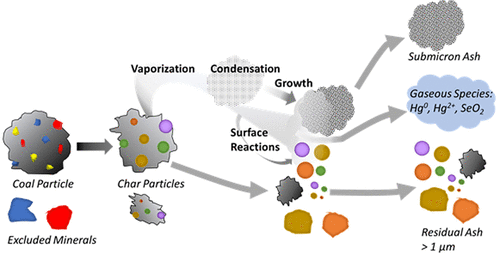当前位置:
X-MOL 学术
›
Energy Fuels
›
论文详情
Our official English website, www.x-mol.net, welcomes your
feedback! (Note: you will need to create a separate account there.)
Chemistry of Trace Inorganic Elements in Coal Combustion Systems: A Century of Discovery
Energy & Fuels ( IF 5.2 ) Pub Date : 2020-09-23 , DOI: 10.1021/acs.energyfuels.0c02375 Constance Senior 1 , Evan Granite 2 , William Linak 3 , Wayne Seames 4
Energy & Fuels ( IF 5.2 ) Pub Date : 2020-09-23 , DOI: 10.1021/acs.energyfuels.0c02375 Constance Senior 1 , Evan Granite 2 , William Linak 3 , Wayne Seames 4
Affiliation

|
Coal fueled the Industrial Revolution and the global expansion of electrification in the 20th century. In the 21st century, coal use has declined in North America and Europe but continues to increase in Asia. Coal contains many of the elements of the Periodic Table, in percent levels or trace amounts (parts per million or parts per billion). The impact of many of these elements on the environment via air emissions and water discharges from coal-fired plants has been studied, with decades of research on their chemical transformations within combustion systems and their fates upon re-introduction into the environment. The transformations of trace elements present in coal burned during combustion can be categorized as thermal volatilizations from the coal in the furnace, thermal decomposition of trace element compounds inside the coal, encapsulation inside ash structures through high-temperature vitrification, oxidation of trace elements with the myriad of species contained in flue gas through gas phase (homogeneous) reactions or catalytic (gas–solid) reactions, adsorption and/or reactions with active sites on entrained fly ash particulates contained in the flue gas, and absorption into solutions. These transformations can, in many cases, impact the fraction of these trace elements that are removed by various pollution control devices compared to the fraction released into the environment. The sampling and measurement of trace elements, in the inlet coal, outlet flue gas, aqueous scrubber solutions, and ash matrices, represent a significant challenge. This review focuses on the behavior of trace elements in industrial coal combustion systems with an emphasis on what has been learned over the past century uniquely related to the use of coal in boilers for electricity and heat production. Key accomplishments in measurement, modeling, and control of trace element emissions in coal-fired systems are highlighted.
中文翻译:

煤燃烧系统中痕量无机元素的化学:一个世纪的发现
煤炭在 20 世纪推动了工业革命和电气化的全球扩张。在 21 世纪,北美和欧洲的煤炭使用量下降,但亚洲的煤炭使用量继续增加。煤以百分比或微量(百万分之几或十亿分之几)的形式包含元素周期表中的许多元素。已经研究了许多这些元素通过燃煤电厂的空气排放和水排放对环境的影响,对它们在燃烧系统中的化学转化及其重新引入环境后的归宿进行了数十年的研究。燃烧过程中燃烧的煤中存在的微量元素的转化可归类为炉内煤的热挥发、煤内微量元素化合物的热分解、通过高温玻璃化、通过气相(均相)反应或催化(气-固)反应、吸附和/或夹带飞蝇上活性位点的反应,将微量元素与烟道气中含有的无数物种氧化成灰结构烟气中含有的灰分颗粒,并吸收到溶液中。在许多情况下,与释放到环境中的部分相比,这些转变会影响由各种污染控制设备去除的这些微量元素的部分。入口煤、出口烟道气、水性洗涤器溶液和灰基质中痕量元素的采样和测量是一项重大挑战。本综述重点关注工业燃煤系统中微量元素的行为,重点介绍过去一个世纪中与在锅炉中使用煤炭发电和供热有关的知识。重点介绍了燃煤系统中微量元素排放的测量、建模和控制方面的主要成就。
更新日期:2020-09-23
中文翻译:

煤燃烧系统中痕量无机元素的化学:一个世纪的发现
煤炭在 20 世纪推动了工业革命和电气化的全球扩张。在 21 世纪,北美和欧洲的煤炭使用量下降,但亚洲的煤炭使用量继续增加。煤以百分比或微量(百万分之几或十亿分之几)的形式包含元素周期表中的许多元素。已经研究了许多这些元素通过燃煤电厂的空气排放和水排放对环境的影响,对它们在燃烧系统中的化学转化及其重新引入环境后的归宿进行了数十年的研究。燃烧过程中燃烧的煤中存在的微量元素的转化可归类为炉内煤的热挥发、煤内微量元素化合物的热分解、通过高温玻璃化、通过气相(均相)反应或催化(气-固)反应、吸附和/或夹带飞蝇上活性位点的反应,将微量元素与烟道气中含有的无数物种氧化成灰结构烟气中含有的灰分颗粒,并吸收到溶液中。在许多情况下,与释放到环境中的部分相比,这些转变会影响由各种污染控制设备去除的这些微量元素的部分。入口煤、出口烟道气、水性洗涤器溶液和灰基质中痕量元素的采样和测量是一项重大挑战。本综述重点关注工业燃煤系统中微量元素的行为,重点介绍过去一个世纪中与在锅炉中使用煤炭发电和供热有关的知识。重点介绍了燃煤系统中微量元素排放的测量、建模和控制方面的主要成就。











































 京公网安备 11010802027423号
京公网安备 11010802027423号